PSY349 Project: Statistical Analysis of Child Development Factors
VerifiedAdded on 2023/06/12
|20
|4070
|296
Report
AI Summary
This report analyzes the factors influencing child development and school adjustment using statistical methods. It investigates the impact of early literacy, numeracy, attention problems, preschool type, gender, maternal depression, school readiness, family income, and classroom quality on academic ability and social adjustment. The analysis employs linear regression and t-tests to determine significant relationships between these variables. The findings suggest that early literacy and numeracy, as well as attention problems, significantly predict academic ability. Kindergarten classroom quality is identified as a significant predictor of social adjustment. Furthermore, the study reveals statistically significant differences in social adjustment and kindergarten classroom quality among children from different preschools. This report provides valuable insights into the complex interplay of factors affecting children's early development and their transition to school. Desklib provides access to a wealth of similar solved assignments and past papers for students.
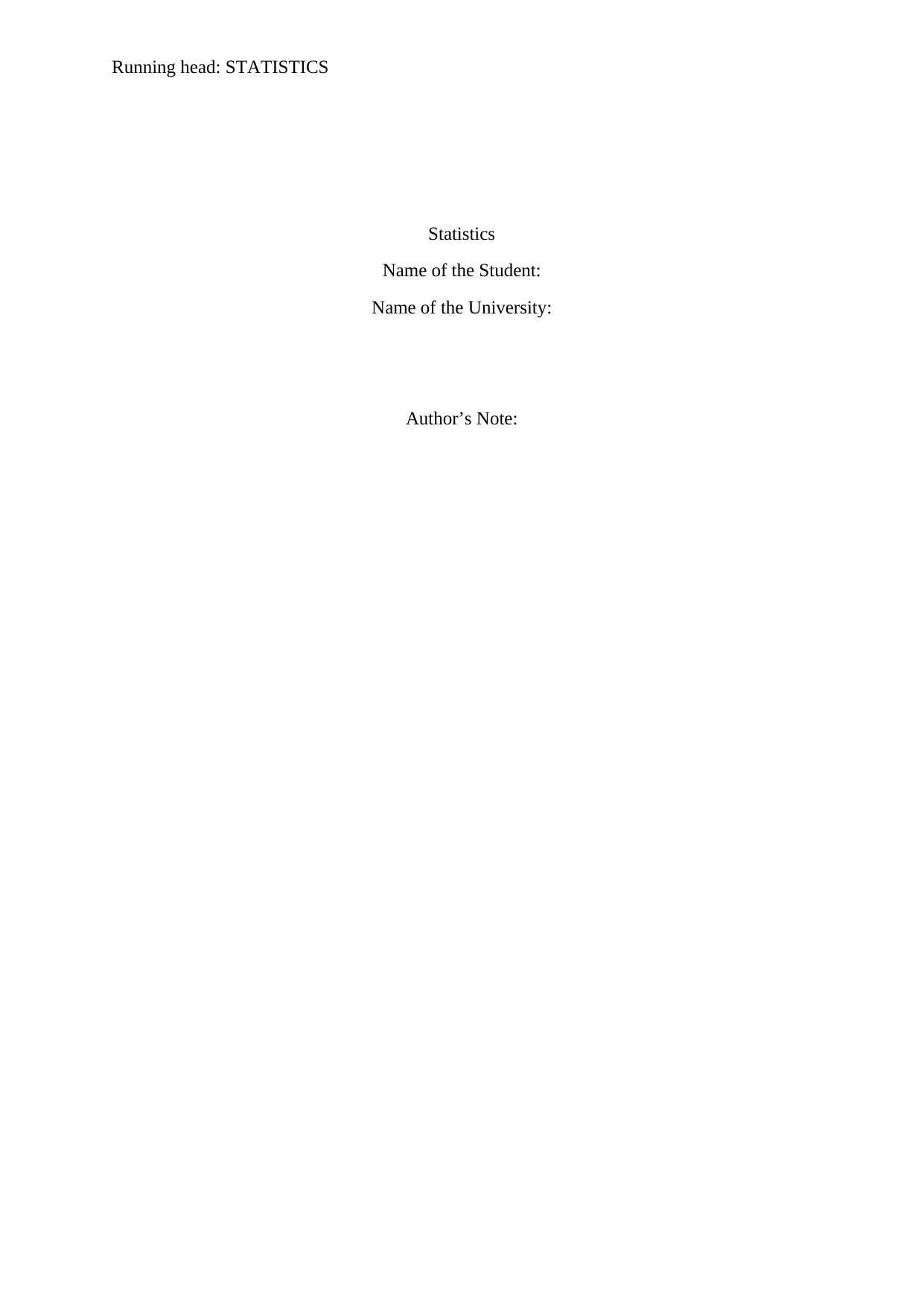
Running head: STATISTICS
Statistics
Name of the Student:
Name of the University:
Author’s Note:
Statistics
Name of the Student:
Name of the University:
Author’s Note:
Paraphrase This Document
Need a fresh take? Get an instant paraphrase of this document with our AI Paraphraser
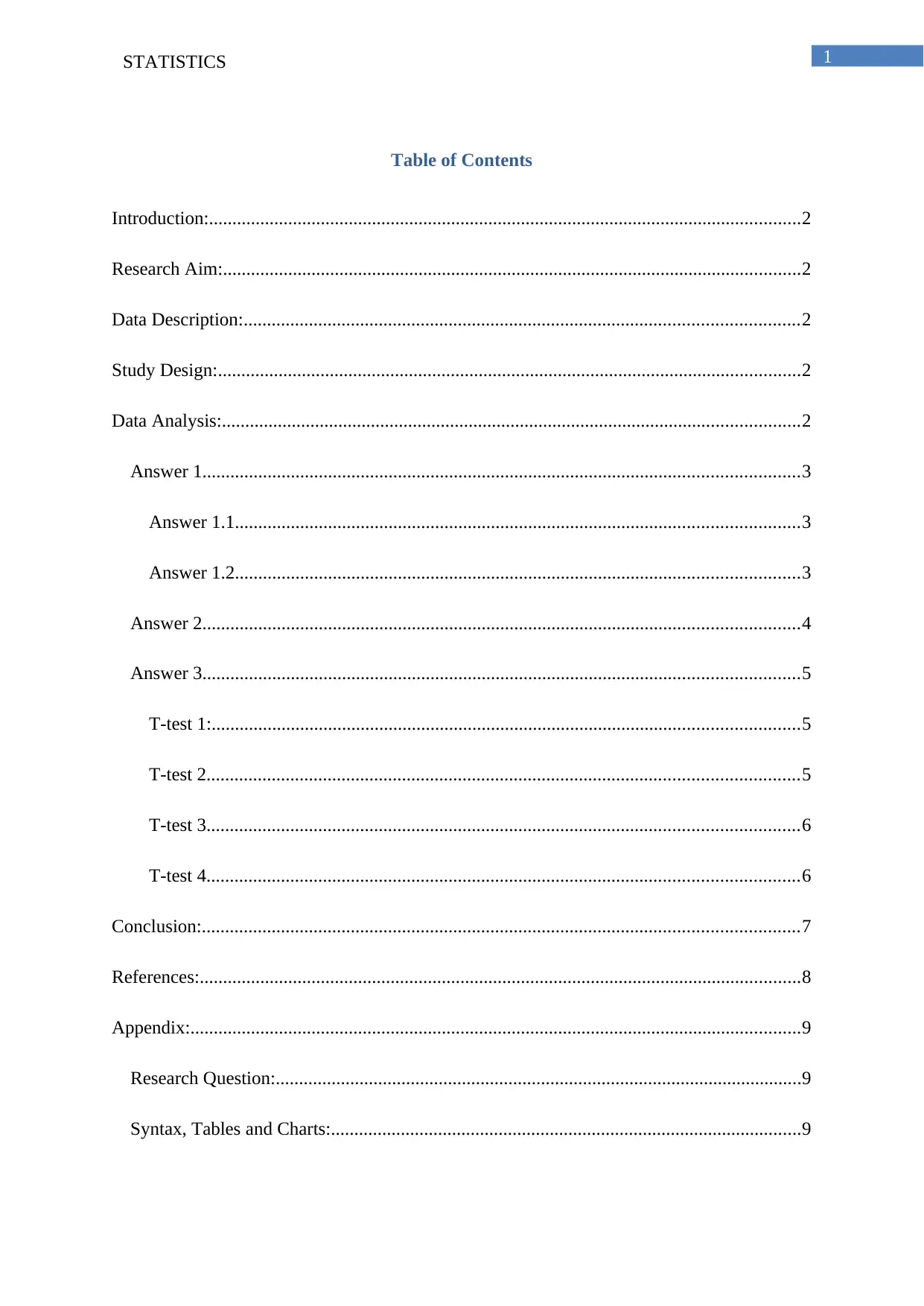
1STATISTICS
Table of Contents
Introduction:...............................................................................................................................2
Research Aim:............................................................................................................................2
Data Description:.......................................................................................................................2
Study Design:.............................................................................................................................2
Data Analysis:............................................................................................................................2
Answer 1................................................................................................................................3
Answer 1.1.........................................................................................................................3
Answer 1.2.........................................................................................................................3
Answer 2................................................................................................................................4
Answer 3................................................................................................................................5
T-test 1:..............................................................................................................................5
T-test 2...............................................................................................................................5
T-test 3...............................................................................................................................6
T-test 4...............................................................................................................................6
Conclusion:................................................................................................................................7
References:.................................................................................................................................8
Appendix:...................................................................................................................................9
Research Question:.................................................................................................................9
Syntax, Tables and Charts:.....................................................................................................9
Table of Contents
Introduction:...............................................................................................................................2
Research Aim:............................................................................................................................2
Data Description:.......................................................................................................................2
Study Design:.............................................................................................................................2
Data Analysis:............................................................................................................................2
Answer 1................................................................................................................................3
Answer 1.1.........................................................................................................................3
Answer 1.2.........................................................................................................................3
Answer 2................................................................................................................................4
Answer 3................................................................................................................................5
T-test 1:..............................................................................................................................5
T-test 2...............................................................................................................................5
T-test 3...............................................................................................................................6
T-test 4...............................................................................................................................6
Conclusion:................................................................................................................................7
References:.................................................................................................................................8
Appendix:...................................................................................................................................9
Research Question:.................................................................................................................9
Syntax, Tables and Charts:.....................................................................................................9

2STATISTICS
⊘ This is a preview!⊘
Do you want full access?
Subscribe today to unlock all pages.

Trusted by 1+ million students worldwide
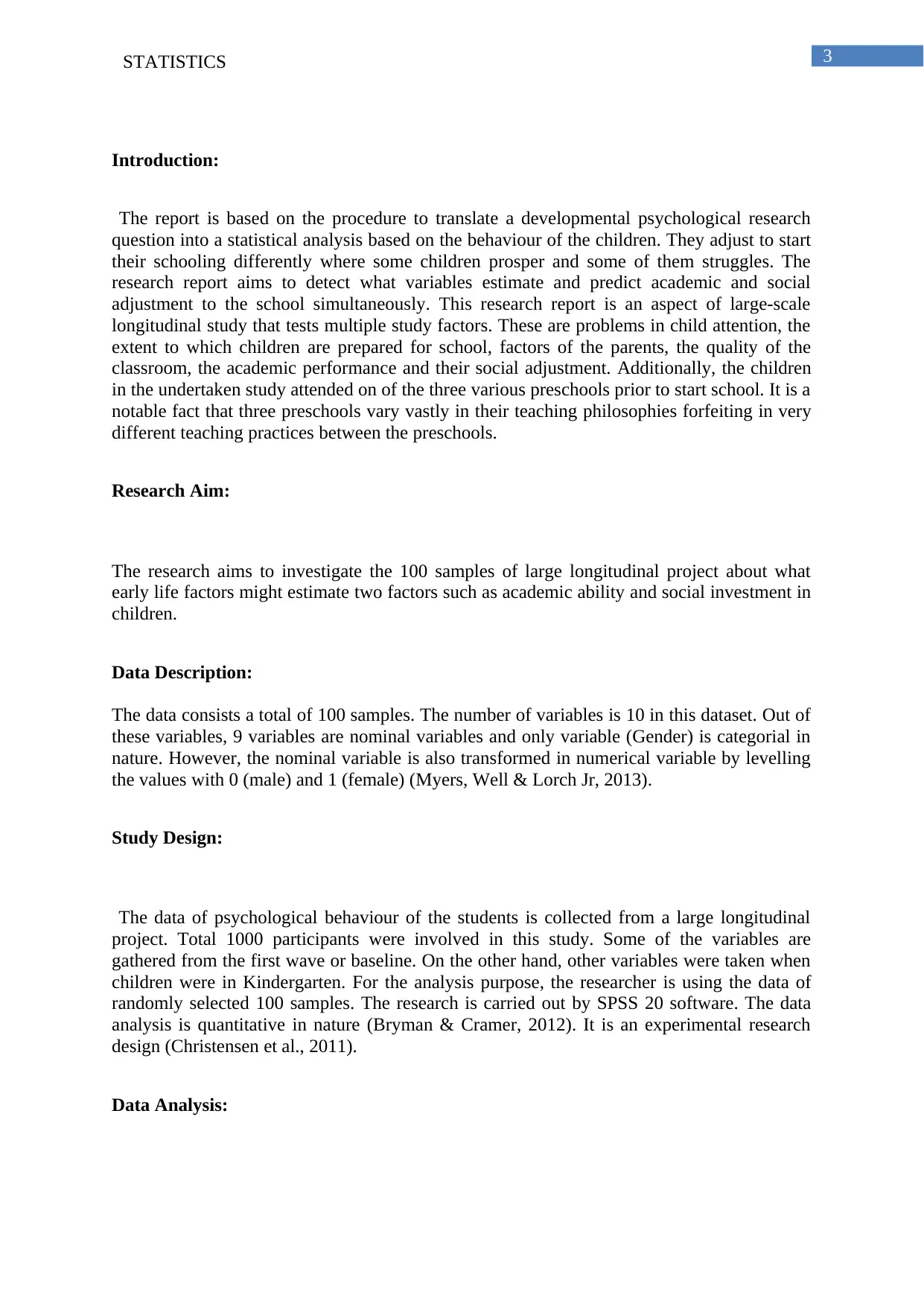
3STATISTICS
Introduction:
The report is based on the procedure to translate a developmental psychological research
question into a statistical analysis based on the behaviour of the children. They adjust to start
their schooling differently where some children prosper and some of them struggles. The
research report aims to detect what variables estimate and predict academic and social
adjustment to the school simultaneously. This research report is an aspect of large-scale
longitudinal study that tests multiple study factors. These are problems in child attention, the
extent to which children are prepared for school, factors of the parents, the quality of the
classroom, the academic performance and their social adjustment. Additionally, the children
in the undertaken study attended on of the three various preschools prior to start school. It is a
notable fact that three preschools vary vastly in their teaching philosophies forfeiting in very
different teaching practices between the preschools.
Research Aim:
The research aims to investigate the 100 samples of large longitudinal project about what
early life factors might estimate two factors such as academic ability and social investment in
children.
Data Description:
The data consists a total of 100 samples. The number of variables is 10 in this dataset. Out of
these variables, 9 variables are nominal variables and only variable (Gender) is categorial in
nature. However, the nominal variable is also transformed in numerical variable by levelling
the values with 0 (male) and 1 (female) (Myers, Well & Lorch Jr, 2013).
Study Design:
The data of psychological behaviour of the students is collected from a large longitudinal
project. Total 1000 participants were involved in this study. Some of the variables are
gathered from the first wave or baseline. On the other hand, other variables were taken when
children were in Kindergarten. For the analysis purpose, the researcher is using the data of
randomly selected 100 samples. The research is carried out by SPSS 20 software. The data
analysis is quantitative in nature (Bryman & Cramer, 2012). It is an experimental research
design (Christensen et al., 2011).
Data Analysis:
Introduction:
The report is based on the procedure to translate a developmental psychological research
question into a statistical analysis based on the behaviour of the children. They adjust to start
their schooling differently where some children prosper and some of them struggles. The
research report aims to detect what variables estimate and predict academic and social
adjustment to the school simultaneously. This research report is an aspect of large-scale
longitudinal study that tests multiple study factors. These are problems in child attention, the
extent to which children are prepared for school, factors of the parents, the quality of the
classroom, the academic performance and their social adjustment. Additionally, the children
in the undertaken study attended on of the three various preschools prior to start school. It is a
notable fact that three preschools vary vastly in their teaching philosophies forfeiting in very
different teaching practices between the preschools.
Research Aim:
The research aims to investigate the 100 samples of large longitudinal project about what
early life factors might estimate two factors such as academic ability and social investment in
children.
Data Description:
The data consists a total of 100 samples. The number of variables is 10 in this dataset. Out of
these variables, 9 variables are nominal variables and only variable (Gender) is categorial in
nature. However, the nominal variable is also transformed in numerical variable by levelling
the values with 0 (male) and 1 (female) (Myers, Well & Lorch Jr, 2013).
Study Design:
The data of psychological behaviour of the students is collected from a large longitudinal
project. Total 1000 participants were involved in this study. Some of the variables are
gathered from the first wave or baseline. On the other hand, other variables were taken when
children were in Kindergarten. For the analysis purpose, the researcher is using the data of
randomly selected 100 samples. The research is carried out by SPSS 20 software. The data
analysis is quantitative in nature (Bryman & Cramer, 2012). It is an experimental research
design (Christensen et al., 2011).
Data Analysis:
Paraphrase This Document
Need a fresh take? Get an instant paraphrase of this document with our AI Paraphraser
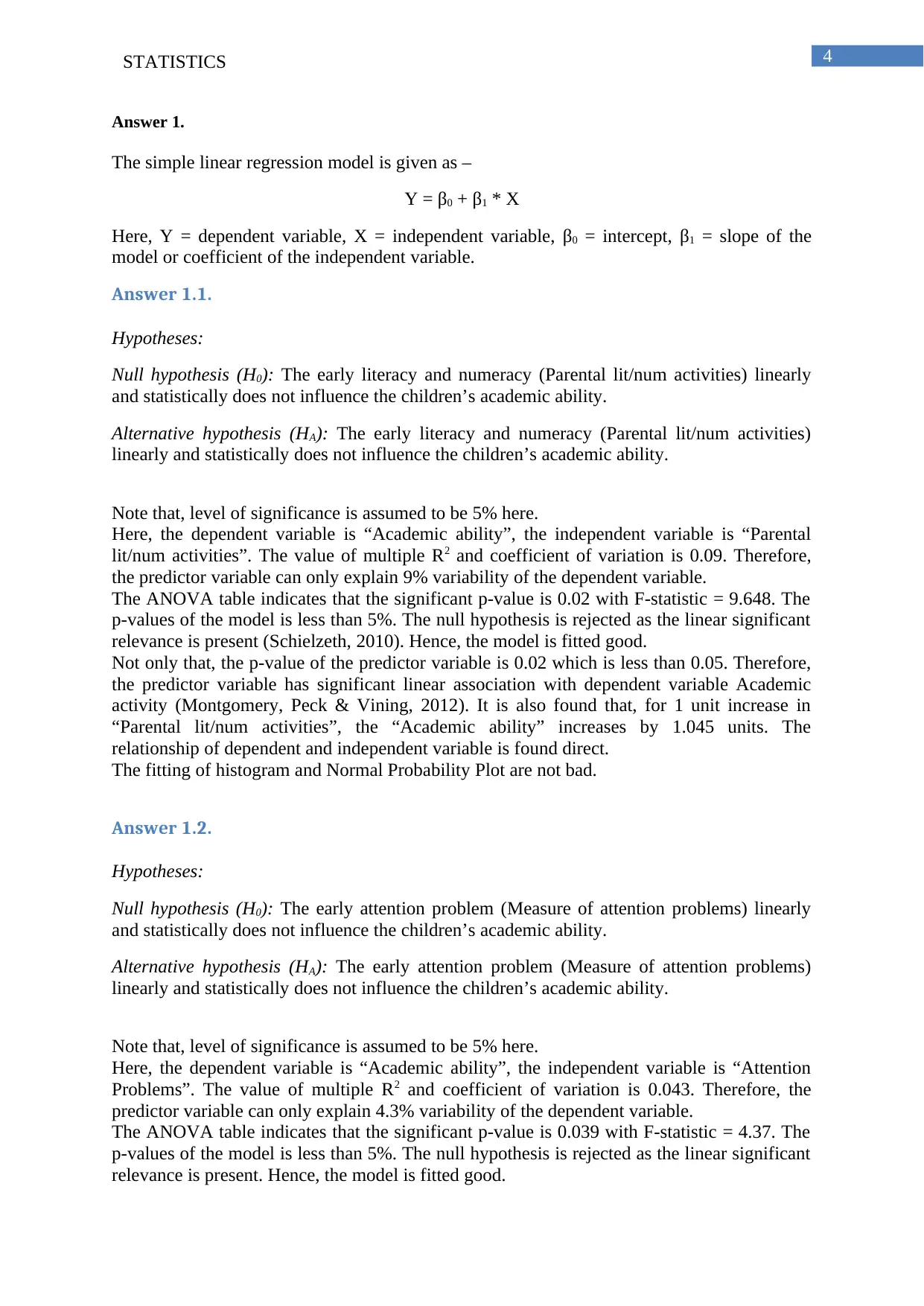
4STATISTICS
Answer 1.
The simple linear regression model is given as –
Y = β0 + β1 * X
Here, Y = dependent variable, X = independent variable, β0 = intercept, β1 = slope of the
model or coefficient of the independent variable.
Answer 1.1.
Hypotheses:
Null hypothesis (H0): The early literacy and numeracy (Parental lit/num activities) linearly
and statistically does not influence the children’s academic ability.
Alternative hypothesis (HA): The early literacy and numeracy (Parental lit/num activities)
linearly and statistically does not influence the children’s academic ability.
Note that, level of significance is assumed to be 5% here.
Here, the dependent variable is “Academic ability”, the independent variable is “Parental
lit/num activities”. The value of multiple R2 and coefficient of variation is 0.09. Therefore,
the predictor variable can only explain 9% variability of the dependent variable.
The ANOVA table indicates that the significant p-value is 0.02 with F-statistic = 9.648. The
p-values of the model is less than 5%. The null hypothesis is rejected as the linear significant
relevance is present (Schielzeth, 2010). Hence, the model is fitted good.
Not only that, the p-value of the predictor variable is 0.02 which is less than 0.05. Therefore,
the predictor variable has significant linear association with dependent variable Academic
activity (Montgomery, Peck & Vining, 2012). It is also found that, for 1 unit increase in
“Parental lit/num activities”, the “Academic ability” increases by 1.045 units. The
relationship of dependent and independent variable is found direct.
The fitting of histogram and Normal Probability Plot are not bad.
Answer 1.2.
Hypotheses:
Null hypothesis (H0): The early attention problem (Measure of attention problems) linearly
and statistically does not influence the children’s academic ability.
Alternative hypothesis (HA): The early attention problem (Measure of attention problems)
linearly and statistically does not influence the children’s academic ability.
Note that, level of significance is assumed to be 5% here.
Here, the dependent variable is “Academic ability”, the independent variable is “Attention
Problems”. The value of multiple R2 and coefficient of variation is 0.043. Therefore, the
predictor variable can only explain 4.3% variability of the dependent variable.
The ANOVA table indicates that the significant p-value is 0.039 with F-statistic = 4.37. The
p-values of the model is less than 5%. The null hypothesis is rejected as the linear significant
relevance is present. Hence, the model is fitted good.
Answer 1.
The simple linear regression model is given as –
Y = β0 + β1 * X
Here, Y = dependent variable, X = independent variable, β0 = intercept, β1 = slope of the
model or coefficient of the independent variable.
Answer 1.1.
Hypotheses:
Null hypothesis (H0): The early literacy and numeracy (Parental lit/num activities) linearly
and statistically does not influence the children’s academic ability.
Alternative hypothesis (HA): The early literacy and numeracy (Parental lit/num activities)
linearly and statistically does not influence the children’s academic ability.
Note that, level of significance is assumed to be 5% here.
Here, the dependent variable is “Academic ability”, the independent variable is “Parental
lit/num activities”. The value of multiple R2 and coefficient of variation is 0.09. Therefore,
the predictor variable can only explain 9% variability of the dependent variable.
The ANOVA table indicates that the significant p-value is 0.02 with F-statistic = 9.648. The
p-values of the model is less than 5%. The null hypothesis is rejected as the linear significant
relevance is present (Schielzeth, 2010). Hence, the model is fitted good.
Not only that, the p-value of the predictor variable is 0.02 which is less than 0.05. Therefore,
the predictor variable has significant linear association with dependent variable Academic
activity (Montgomery, Peck & Vining, 2012). It is also found that, for 1 unit increase in
“Parental lit/num activities”, the “Academic ability” increases by 1.045 units. The
relationship of dependent and independent variable is found direct.
The fitting of histogram and Normal Probability Plot are not bad.
Answer 1.2.
Hypotheses:
Null hypothesis (H0): The early attention problem (Measure of attention problems) linearly
and statistically does not influence the children’s academic ability.
Alternative hypothesis (HA): The early attention problem (Measure of attention problems)
linearly and statistically does not influence the children’s academic ability.
Note that, level of significance is assumed to be 5% here.
Here, the dependent variable is “Academic ability”, the independent variable is “Attention
Problems”. The value of multiple R2 and coefficient of variation is 0.043. Therefore, the
predictor variable can only explain 4.3% variability of the dependent variable.
The ANOVA table indicates that the significant p-value is 0.039 with F-statistic = 4.37. The
p-values of the model is less than 5%. The null hypothesis is rejected as the linear significant
relevance is present. Hence, the model is fitted good.
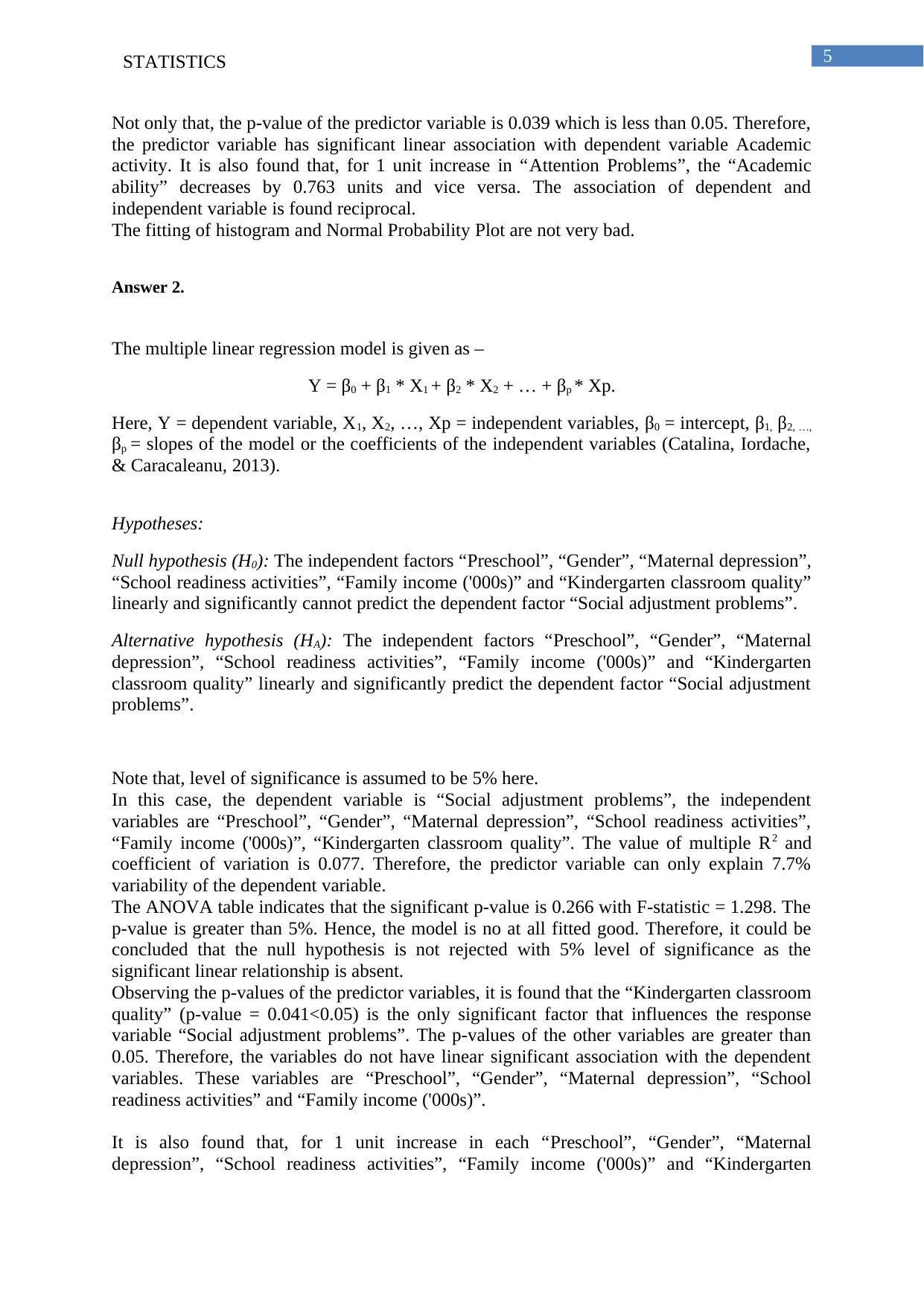
5STATISTICS
Not only that, the p-value of the predictor variable is 0.039 which is less than 0.05. Therefore,
the predictor variable has significant linear association with dependent variable Academic
activity. It is also found that, for 1 unit increase in “Attention Problems”, the “Academic
ability” decreases by 0.763 units and vice versa. The association of dependent and
independent variable is found reciprocal.
The fitting of histogram and Normal Probability Plot are not very bad.
Answer 2.
The multiple linear regression model is given as –
Y = β0 + β1 * X1 + β2 * X2 + … + βp * Xp.
Here, Y = dependent variable, X1, X2, …, Xp = independent variables, β0 = intercept, β1, β2, …,
βp = slopes of the model or the coefficients of the independent variables (Catalina, Iordache,
& Caracaleanu, 2013).
Hypotheses:
Null hypothesis (H0): The independent factors “Preschool”, “Gender”, “Maternal depression”,
“School readiness activities”, “Family income ('000s)” and “Kindergarten classroom quality”
linearly and significantly cannot predict the dependent factor “Social adjustment problems”.
Alternative hypothesis (HA): The independent factors “Preschool”, “Gender”, “Maternal
depression”, “School readiness activities”, “Family income ('000s)” and “Kindergarten
classroom quality” linearly and significantly predict the dependent factor “Social adjustment
problems”.
Note that, level of significance is assumed to be 5% here.
In this case, the dependent variable is “Social adjustment problems”, the independent
variables are “Preschool”, “Gender”, “Maternal depression”, “School readiness activities”,
“Family income ('000s)”, “Kindergarten classroom quality”. The value of multiple R2 and
coefficient of variation is 0.077. Therefore, the predictor variable can only explain 7.7%
variability of the dependent variable.
The ANOVA table indicates that the significant p-value is 0.266 with F-statistic = 1.298. The
p-value is greater than 5%. Hence, the model is no at all fitted good. Therefore, it could be
concluded that the null hypothesis is not rejected with 5% level of significance as the
significant linear relationship is absent.
Observing the p-values of the predictor variables, it is found that the “Kindergarten classroom
quality” (p-value = 0.041<0.05) is the only significant factor that influences the response
variable “Social adjustment problems”. The p-values of the other variables are greater than
0.05. Therefore, the variables do not have linear significant association with the dependent
variables. These variables are “Preschool”, “Gender”, “Maternal depression”, “School
readiness activities” and “Family income ('000s)”.
It is also found that, for 1 unit increase in each “Preschool”, “Gender”, “Maternal
depression”, “School readiness activities”, “Family income ('000s)” and “Kindergarten
Not only that, the p-value of the predictor variable is 0.039 which is less than 0.05. Therefore,
the predictor variable has significant linear association with dependent variable Academic
activity. It is also found that, for 1 unit increase in “Attention Problems”, the “Academic
ability” decreases by 0.763 units and vice versa. The association of dependent and
independent variable is found reciprocal.
The fitting of histogram and Normal Probability Plot are not very bad.
Answer 2.
The multiple linear regression model is given as –
Y = β0 + β1 * X1 + β2 * X2 + … + βp * Xp.
Here, Y = dependent variable, X1, X2, …, Xp = independent variables, β0 = intercept, β1, β2, …,
βp = slopes of the model or the coefficients of the independent variables (Catalina, Iordache,
& Caracaleanu, 2013).
Hypotheses:
Null hypothesis (H0): The independent factors “Preschool”, “Gender”, “Maternal depression”,
“School readiness activities”, “Family income ('000s)” and “Kindergarten classroom quality”
linearly and significantly cannot predict the dependent factor “Social adjustment problems”.
Alternative hypothesis (HA): The independent factors “Preschool”, “Gender”, “Maternal
depression”, “School readiness activities”, “Family income ('000s)” and “Kindergarten
classroom quality” linearly and significantly predict the dependent factor “Social adjustment
problems”.
Note that, level of significance is assumed to be 5% here.
In this case, the dependent variable is “Social adjustment problems”, the independent
variables are “Preschool”, “Gender”, “Maternal depression”, “School readiness activities”,
“Family income ('000s)”, “Kindergarten classroom quality”. The value of multiple R2 and
coefficient of variation is 0.077. Therefore, the predictor variable can only explain 7.7%
variability of the dependent variable.
The ANOVA table indicates that the significant p-value is 0.266 with F-statistic = 1.298. The
p-value is greater than 5%. Hence, the model is no at all fitted good. Therefore, it could be
concluded that the null hypothesis is not rejected with 5% level of significance as the
significant linear relationship is absent.
Observing the p-values of the predictor variables, it is found that the “Kindergarten classroom
quality” (p-value = 0.041<0.05) is the only significant factor that influences the response
variable “Social adjustment problems”. The p-values of the other variables are greater than
0.05. Therefore, the variables do not have linear significant association with the dependent
variables. These variables are “Preschool”, “Gender”, “Maternal depression”, “School
readiness activities” and “Family income ('000s)”.
It is also found that, for 1 unit increase in each “Preschool”, “Gender”, “Maternal
depression”, “School readiness activities”, “Family income ('000s)” and “Kindergarten
⊘ This is a preview!⊘
Do you want full access?
Subscribe today to unlock all pages.

Trusted by 1+ million students worldwide
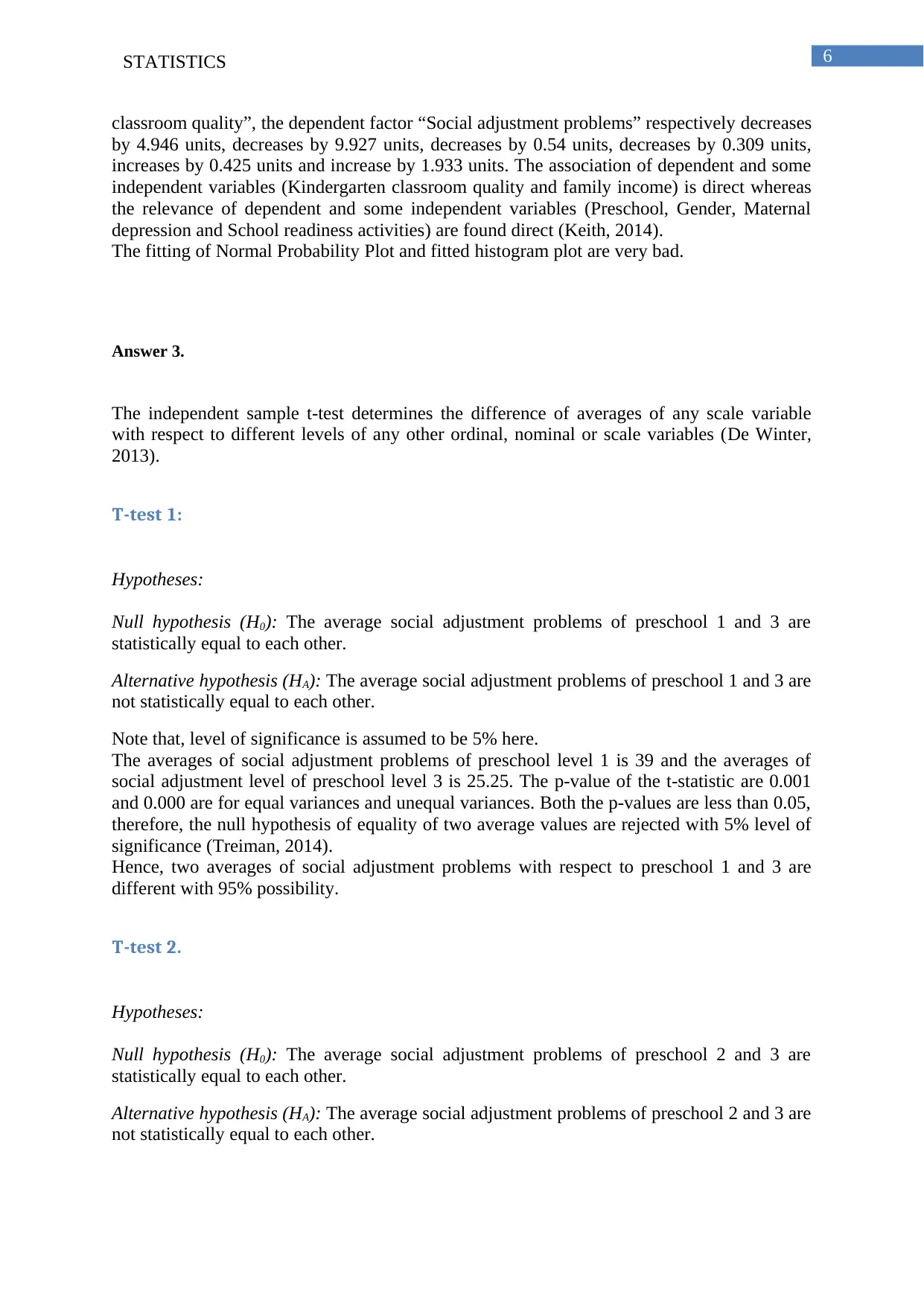
6STATISTICS
classroom quality”, the dependent factor “Social adjustment problems” respectively decreases
by 4.946 units, decreases by 9.927 units, decreases by 0.54 units, decreases by 0.309 units,
increases by 0.425 units and increase by 1.933 units. The association of dependent and some
independent variables (Kindergarten classroom quality and family income) is direct whereas
the relevance of dependent and some independent variables (Preschool, Gender, Maternal
depression and School readiness activities) are found direct (Keith, 2014).
The fitting of Normal Probability Plot and fitted histogram plot are very bad.
Answer 3.
The independent sample t-test determines the difference of averages of any scale variable
with respect to different levels of any other ordinal, nominal or scale variables (De Winter,
2013).
T-test 1:
Hypotheses:
Null hypothesis (H0): The average social adjustment problems of preschool 1 and 3 are
statistically equal to each other.
Alternative hypothesis (HA): The average social adjustment problems of preschool 1 and 3 are
not statistically equal to each other.
Note that, level of significance is assumed to be 5% here.
The averages of social adjustment problems of preschool level 1 is 39 and the averages of
social adjustment level of preschool level 3 is 25.25. The p-value of the t-statistic are 0.001
and 0.000 are for equal variances and unequal variances. Both the p-values are less than 0.05,
therefore, the null hypothesis of equality of two average values are rejected with 5% level of
significance (Treiman, 2014).
Hence, two averages of social adjustment problems with respect to preschool 1 and 3 are
different with 95% possibility.
T-test 2.
Hypotheses:
Null hypothesis (H0): The average social adjustment problems of preschool 2 and 3 are
statistically equal to each other.
Alternative hypothesis (HA): The average social adjustment problems of preschool 2 and 3 are
not statistically equal to each other.
classroom quality”, the dependent factor “Social adjustment problems” respectively decreases
by 4.946 units, decreases by 9.927 units, decreases by 0.54 units, decreases by 0.309 units,
increases by 0.425 units and increase by 1.933 units. The association of dependent and some
independent variables (Kindergarten classroom quality and family income) is direct whereas
the relevance of dependent and some independent variables (Preschool, Gender, Maternal
depression and School readiness activities) are found direct (Keith, 2014).
The fitting of Normal Probability Plot and fitted histogram plot are very bad.
Answer 3.
The independent sample t-test determines the difference of averages of any scale variable
with respect to different levels of any other ordinal, nominal or scale variables (De Winter,
2013).
T-test 1:
Hypotheses:
Null hypothesis (H0): The average social adjustment problems of preschool 1 and 3 are
statistically equal to each other.
Alternative hypothesis (HA): The average social adjustment problems of preschool 1 and 3 are
not statistically equal to each other.
Note that, level of significance is assumed to be 5% here.
The averages of social adjustment problems of preschool level 1 is 39 and the averages of
social adjustment level of preschool level 3 is 25.25. The p-value of the t-statistic are 0.001
and 0.000 are for equal variances and unequal variances. Both the p-values are less than 0.05,
therefore, the null hypothesis of equality of two average values are rejected with 5% level of
significance (Treiman, 2014).
Hence, two averages of social adjustment problems with respect to preschool 1 and 3 are
different with 95% possibility.
T-test 2.
Hypotheses:
Null hypothesis (H0): The average social adjustment problems of preschool 2 and 3 are
statistically equal to each other.
Alternative hypothesis (HA): The average social adjustment problems of preschool 2 and 3 are
not statistically equal to each other.
Paraphrase This Document
Need a fresh take? Get an instant paraphrase of this document with our AI Paraphraser

7STATISTICS
Note that, level of significance is assumed to be 5% here.
The averages of social adjustment problems of preschool level 2 is 82.93 and the averages of
social adjustment level of preschool level 2 is 25.25. The p-value of the t-statistic are 0.000
and 0.000 are for equal variances and unequal variances. Both the p-values are less than 0.05,
therefore, the null hypothesis of equality of two average values are rejected with 5% level of
significance.
Hence, two averages of social adjustment problems with respect to preschool 2 and 3 are
different with 95% possibility.
T-test 3.
Hypotheses:
Null hypothesis (H0): The average Kindergarten classroom quality of preschool 1 and 3 are
statistically equal to each other.
Alternative hypothesis (HA): The average Kindergarten classroom quality of preschool 1 and
3 are not statistically equal to each other.
Note that, level of significance is assumed to be 5% here.
The averages of Kindergarten classroom quality level of preschool level 1 is 18.26 and the
averages of Kindergarten classroom quality level of preschool level 3 is 23.90. The p-value of
the t-statistic are 0.000 and 0.000 are for equal variances and unequal variances. Both the p-
values are less than 0.05, therefore, the null hypothesis of equality of two average values are
rejected with 5% level of significance.
Hence, two averages of Kindergarten classroom quality with respect to preschool 1 and 3 are
different with 95% possibility.
T-test 4.
Hypotheses:
Null hypothesis (H0): The average Kindergarten classroom quality of preschool 2 and 3 are
statistically equal to each other.
Alternative hypothesis (HA): The average Kindergarten classroom quality of preschool 2 and
3 are not statistically equal to each other.
Note that, level of significance is assumed to be 5% here.
The averages of Kindergarten classroom quality level of preschool level 2 is 19.41 and the
averages of Kindergarten classroom quality level of preschool level 3 is 23.90. The p-value of
the t-statistic are 0.000 and 0.000 are for equal variances and unequal variances. Both the p-
values are less than 0.05, therefore, the null hypothesis of equality of two average values are
rejected with 5% level of significance.
Hence, two averages of Kindergarten classroom quality with respect to preschool 2 and 3 are
different with 95% possibility.
Note that, level of significance is assumed to be 5% here.
The averages of social adjustment problems of preschool level 2 is 82.93 and the averages of
social adjustment level of preschool level 2 is 25.25. The p-value of the t-statistic are 0.000
and 0.000 are for equal variances and unequal variances. Both the p-values are less than 0.05,
therefore, the null hypothesis of equality of two average values are rejected with 5% level of
significance.
Hence, two averages of social adjustment problems with respect to preschool 2 and 3 are
different with 95% possibility.
T-test 3.
Hypotheses:
Null hypothesis (H0): The average Kindergarten classroom quality of preschool 1 and 3 are
statistically equal to each other.
Alternative hypothesis (HA): The average Kindergarten classroom quality of preschool 1 and
3 are not statistically equal to each other.
Note that, level of significance is assumed to be 5% here.
The averages of Kindergarten classroom quality level of preschool level 1 is 18.26 and the
averages of Kindergarten classroom quality level of preschool level 3 is 23.90. The p-value of
the t-statistic are 0.000 and 0.000 are for equal variances and unequal variances. Both the p-
values are less than 0.05, therefore, the null hypothesis of equality of two average values are
rejected with 5% level of significance.
Hence, two averages of Kindergarten classroom quality with respect to preschool 1 and 3 are
different with 95% possibility.
T-test 4.
Hypotheses:
Null hypothesis (H0): The average Kindergarten classroom quality of preschool 2 and 3 are
statistically equal to each other.
Alternative hypothesis (HA): The average Kindergarten classroom quality of preschool 2 and
3 are not statistically equal to each other.
Note that, level of significance is assumed to be 5% here.
The averages of Kindergarten classroom quality level of preschool level 2 is 19.41 and the
averages of Kindergarten classroom quality level of preschool level 3 is 23.90. The p-value of
the t-statistic are 0.000 and 0.000 are for equal variances and unequal variances. Both the p-
values are less than 0.05, therefore, the null hypothesis of equality of two average values are
rejected with 5% level of significance.
Hence, two averages of Kindergarten classroom quality with respect to preschool 2 and 3 are
different with 95% possibility.
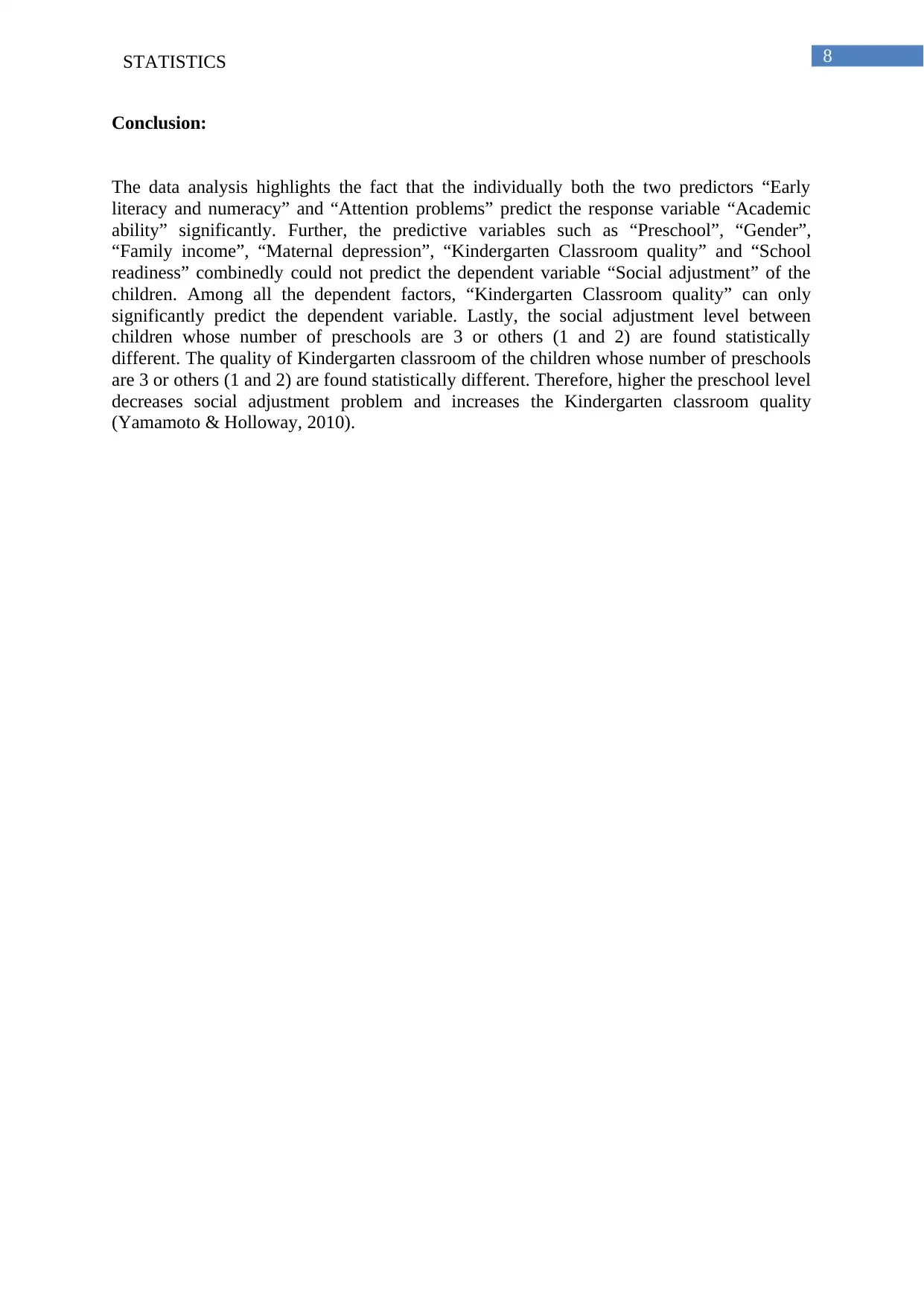
8STATISTICS
Conclusion:
The data analysis highlights the fact that the individually both the two predictors “Early
literacy and numeracy” and “Attention problems” predict the response variable “Academic
ability” significantly. Further, the predictive variables such as “Preschool”, “Gender”,
“Family income”, “Maternal depression”, “Kindergarten Classroom quality” and “School
readiness” combinedly could not predict the dependent variable “Social adjustment” of the
children. Among all the dependent factors, “Kindergarten Classroom quality” can only
significantly predict the dependent variable. Lastly, the social adjustment level between
children whose number of preschools are 3 or others (1 and 2) are found statistically
different. The quality of Kindergarten classroom of the children whose number of preschools
are 3 or others (1 and 2) are found statistically different. Therefore, higher the preschool level
decreases social adjustment problem and increases the Kindergarten classroom quality
(Yamamoto & Holloway, 2010).
Conclusion:
The data analysis highlights the fact that the individually both the two predictors “Early
literacy and numeracy” and “Attention problems” predict the response variable “Academic
ability” significantly. Further, the predictive variables such as “Preschool”, “Gender”,
“Family income”, “Maternal depression”, “Kindergarten Classroom quality” and “School
readiness” combinedly could not predict the dependent variable “Social adjustment” of the
children. Among all the dependent factors, “Kindergarten Classroom quality” can only
significantly predict the dependent variable. Lastly, the social adjustment level between
children whose number of preschools are 3 or others (1 and 2) are found statistically
different. The quality of Kindergarten classroom of the children whose number of preschools
are 3 or others (1 and 2) are found statistically different. Therefore, higher the preschool level
decreases social adjustment problem and increases the Kindergarten classroom quality
(Yamamoto & Holloway, 2010).
⊘ This is a preview!⊘
Do you want full access?
Subscribe today to unlock all pages.

Trusted by 1+ million students worldwide
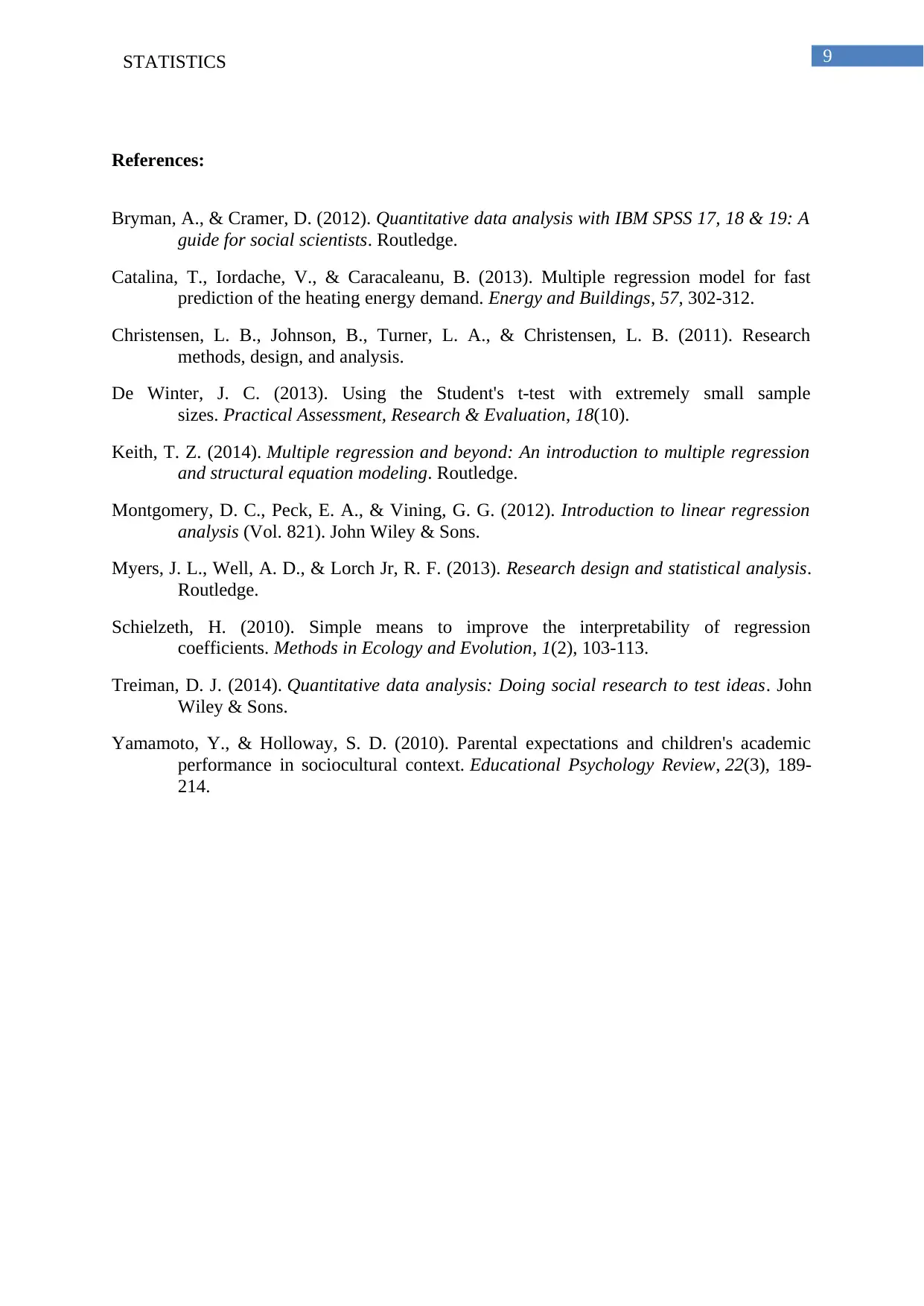
9STATISTICS
References:
Bryman, A., & Cramer, D. (2012). Quantitative data analysis with IBM SPSS 17, 18 & 19: A
guide for social scientists. Routledge.
Catalina, T., Iordache, V., & Caracaleanu, B. (2013). Multiple regression model for fast
prediction of the heating energy demand. Energy and Buildings, 57, 302-312.
Christensen, L. B., Johnson, B., Turner, L. A., & Christensen, L. B. (2011). Research
methods, design, and analysis.
De Winter, J. C. (2013). Using the Student's t-test with extremely small sample
sizes. Practical Assessment, Research & Evaluation, 18(10).
Keith, T. Z. (2014). Multiple regression and beyond: An introduction to multiple regression
and structural equation modeling. Routledge.
Montgomery, D. C., Peck, E. A., & Vining, G. G. (2012). Introduction to linear regression
analysis (Vol. 821). John Wiley & Sons.
Myers, J. L., Well, A. D., & Lorch Jr, R. F. (2013). Research design and statistical analysis.
Routledge.
Schielzeth, H. (2010). Simple means to improve the interpretability of regression
coefficients. Methods in Ecology and Evolution, 1(2), 103-113.
Treiman, D. J. (2014). Quantitative data analysis: Doing social research to test ideas. John
Wiley & Sons.
Yamamoto, Y., & Holloway, S. D. (2010). Parental expectations and children's academic
performance in sociocultural context. Educational Psychology Review, 22(3), 189-
214.
References:
Bryman, A., & Cramer, D. (2012). Quantitative data analysis with IBM SPSS 17, 18 & 19: A
guide for social scientists. Routledge.
Catalina, T., Iordache, V., & Caracaleanu, B. (2013). Multiple regression model for fast
prediction of the heating energy demand. Energy and Buildings, 57, 302-312.
Christensen, L. B., Johnson, B., Turner, L. A., & Christensen, L. B. (2011). Research
methods, design, and analysis.
De Winter, J. C. (2013). Using the Student's t-test with extremely small sample
sizes. Practical Assessment, Research & Evaluation, 18(10).
Keith, T. Z. (2014). Multiple regression and beyond: An introduction to multiple regression
and structural equation modeling. Routledge.
Montgomery, D. C., Peck, E. A., & Vining, G. G. (2012). Introduction to linear regression
analysis (Vol. 821). John Wiley & Sons.
Myers, J. L., Well, A. D., & Lorch Jr, R. F. (2013). Research design and statistical analysis.
Routledge.
Schielzeth, H. (2010). Simple means to improve the interpretability of regression
coefficients. Methods in Ecology and Evolution, 1(2), 103-113.
Treiman, D. J. (2014). Quantitative data analysis: Doing social research to test ideas. John
Wiley & Sons.
Yamamoto, Y., & Holloway, S. D. (2010). Parental expectations and children's academic
performance in sociocultural context. Educational Psychology Review, 22(3), 189-
214.
Paraphrase This Document
Need a fresh take? Get an instant paraphrase of this document with our AI Paraphraser
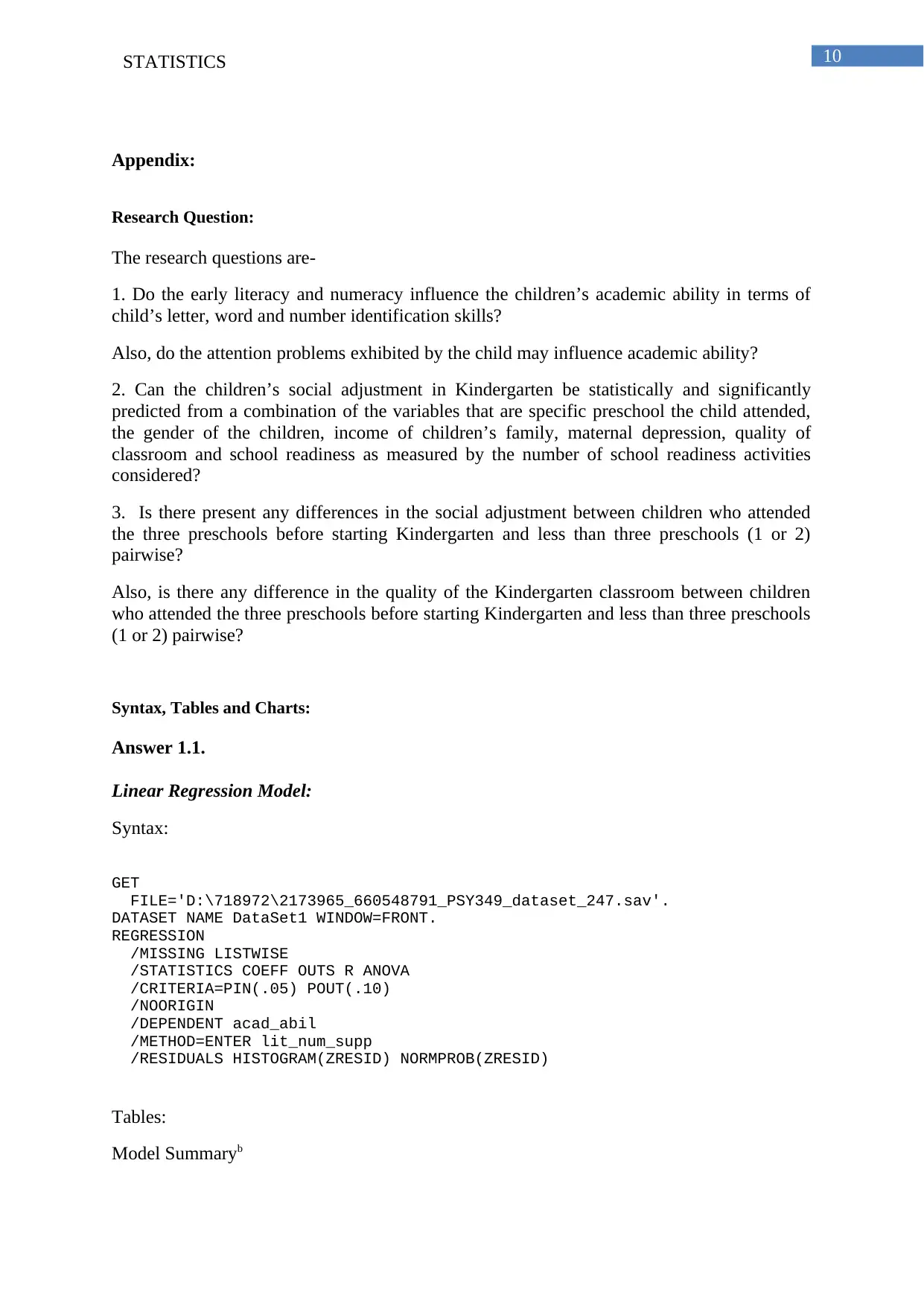
10STATISTICS
Appendix:
Research Question:
The research questions are-
1. Do the early literacy and numeracy influence the children’s academic ability in terms of
child’s letter, word and number identification skills?
Also, do the attention problems exhibited by the child may influence academic ability?
2. Can the children’s social adjustment in Kindergarten be statistically and significantly
predicted from a combination of the variables that are specific preschool the child attended,
the gender of the children, income of children’s family, maternal depression, quality of
classroom and school readiness as measured by the number of school readiness activities
considered?
3. Is there present any differences in the social adjustment between children who attended
the three preschools before starting Kindergarten and less than three preschools (1 or 2)
pairwise?
Also, is there any difference in the quality of the Kindergarten classroom between children
who attended the three preschools before starting Kindergarten and less than three preschools
(1 or 2) pairwise?
Syntax, Tables and Charts:
Answer 1.1.
Linear Regression Model:
Syntax:
GET
FILE='D:\718972\2173965_660548791_PSY349_dataset_247.sav'.
DATASET NAME DataSet1 WINDOW=FRONT.
REGRESSION
/MISSING LISTWISE
/STATISTICS COEFF OUTS R ANOVA
/CRITERIA=PIN(.05) POUT(.10)
/NOORIGIN
/DEPENDENT acad_abil
/METHOD=ENTER lit_num_supp
/RESIDUALS HISTOGRAM(ZRESID) NORMPROB(ZRESID)
Tables:
Model Summaryb
Appendix:
Research Question:
The research questions are-
1. Do the early literacy and numeracy influence the children’s academic ability in terms of
child’s letter, word and number identification skills?
Also, do the attention problems exhibited by the child may influence academic ability?
2. Can the children’s social adjustment in Kindergarten be statistically and significantly
predicted from a combination of the variables that are specific preschool the child attended,
the gender of the children, income of children’s family, maternal depression, quality of
classroom and school readiness as measured by the number of school readiness activities
considered?
3. Is there present any differences in the social adjustment between children who attended
the three preschools before starting Kindergarten and less than three preschools (1 or 2)
pairwise?
Also, is there any difference in the quality of the Kindergarten classroom between children
who attended the three preschools before starting Kindergarten and less than three preschools
(1 or 2) pairwise?
Syntax, Tables and Charts:
Answer 1.1.
Linear Regression Model:
Syntax:
GET
FILE='D:\718972\2173965_660548791_PSY349_dataset_247.sav'.
DATASET NAME DataSet1 WINDOW=FRONT.
REGRESSION
/MISSING LISTWISE
/STATISTICS COEFF OUTS R ANOVA
/CRITERIA=PIN(.05) POUT(.10)
/NOORIGIN
/DEPENDENT acad_abil
/METHOD=ENTER lit_num_supp
/RESIDUALS HISTOGRAM(ZRESID) NORMPROB(ZRESID)
Tables:
Model Summaryb
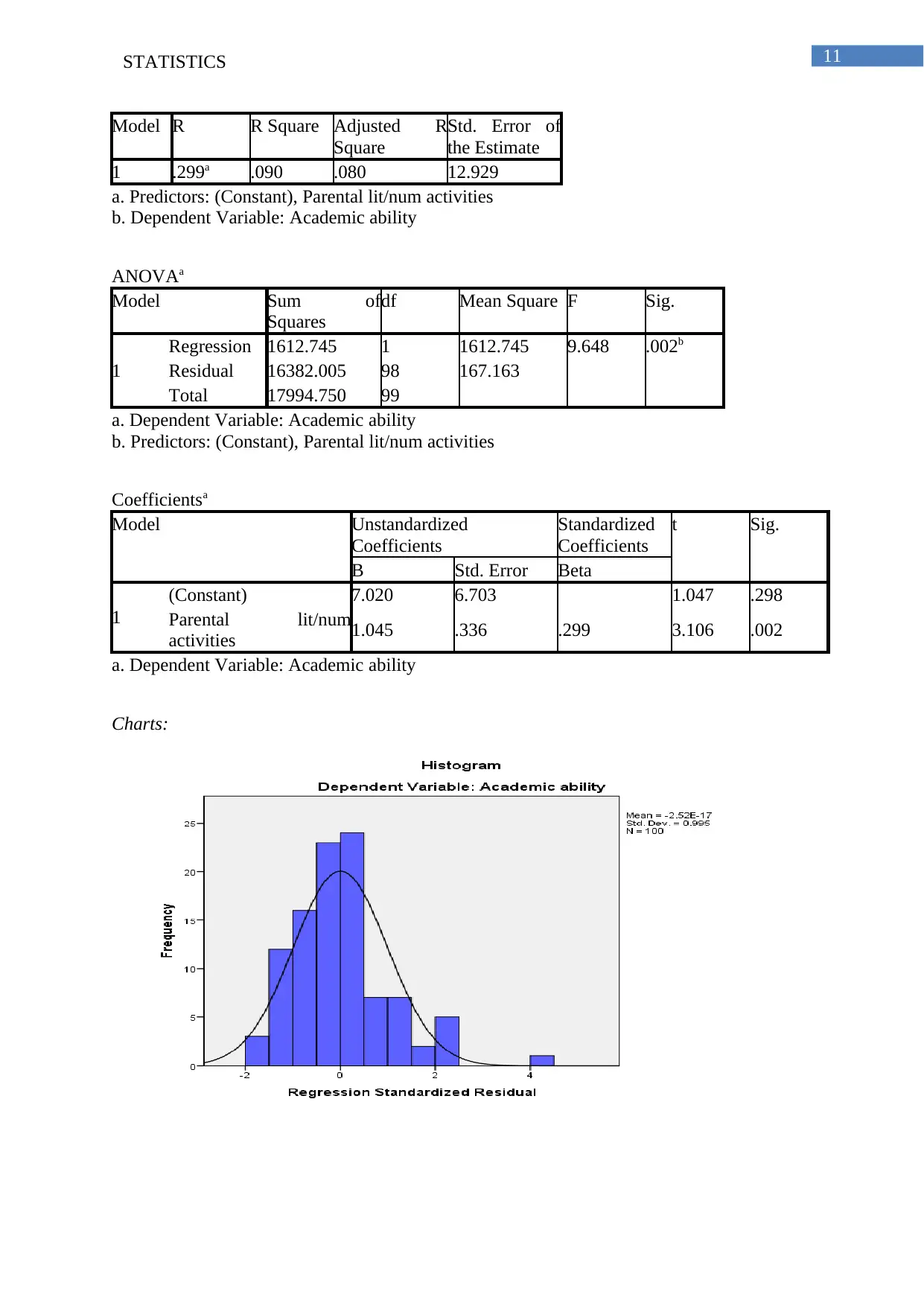
11STATISTICS
Model R R Square Adjusted R
Square
Std. Error of
the Estimate
1 .299a .090 .080 12.929
a. Predictors: (Constant), Parental lit/num activities
b. Dependent Variable: Academic ability
ANOVAa
Model Sum of
Squares
df Mean Square F Sig.
1
Regression 1612.745 1 1612.745 9.648 .002b
Residual 16382.005 98 167.163
Total 17994.750 99
a. Dependent Variable: Academic ability
b. Predictors: (Constant), Parental lit/num activities
Coefficientsa
Model Unstandardized
Coefficients
Standardized
Coefficients
t Sig.
B Std. Error Beta
1
(Constant) 7.020 6.703 1.047 .298
Parental lit/num
activities 1.045 .336 .299 3.106 .002
a. Dependent Variable: Academic ability
Charts:
Model R R Square Adjusted R
Square
Std. Error of
the Estimate
1 .299a .090 .080 12.929
a. Predictors: (Constant), Parental lit/num activities
b. Dependent Variable: Academic ability
ANOVAa
Model Sum of
Squares
df Mean Square F Sig.
1
Regression 1612.745 1 1612.745 9.648 .002b
Residual 16382.005 98 167.163
Total 17994.750 99
a. Dependent Variable: Academic ability
b. Predictors: (Constant), Parental lit/num activities
Coefficientsa
Model Unstandardized
Coefficients
Standardized
Coefficients
t Sig.
B Std. Error Beta
1
(Constant) 7.020 6.703 1.047 .298
Parental lit/num
activities 1.045 .336 .299 3.106 .002
a. Dependent Variable: Academic ability
Charts:
⊘ This is a preview!⊘
Do you want full access?
Subscribe today to unlock all pages.

Trusted by 1+ million students worldwide
1 out of 20
Your All-in-One AI-Powered Toolkit for Academic Success.
+13062052269
info@desklib.com
Available 24*7 on WhatsApp / Email
![[object Object]](/_next/static/media/star-bottom.7253800d.svg)
Unlock your academic potential
Copyright © 2020–2025 A2Z Services. All Rights Reserved. Developed and managed by ZUCOL.
